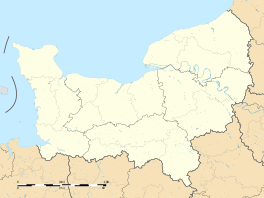Bernières-sur-Mer
| Bernières-sur-Mer | ||
|---|---|---|
| Commune | ||

Notre Dame
|
||
|
||
| Coordinates: 49°19′59″N 0°25′14″W / 49.3331°N 0.4206°WCoordinates: 49°19′59″N 0°25′14″W / 49.3331°N 0.4206°W | ||
| Country | France | |
| Region | Normandy | |
| Department | Calvados | |
| Arrondissement | Caen | |
| Canton | Courseulles-sur-Mer | |
| Government | ||
| • Mayor (2008–2014) | Maryvonne Mottin | |
| Area1 | 7.66 km2 (2.96 sq mi) | |
| Population (2008)2 | 2,371 | |
| • Density | 310/km2 (800/sq mi) | |
| Time zone | CET (UTC+1) | |
| • Summer (DST) | CEST (UTC+2) | |
| INSEE/Postal code | 14066 /14990 | |
| Elevation | 0–55 m (0–180 ft) (avg. 4 m or 13 ft) |
|
|
1 French Land Register data, which excludes lakes, ponds, glaciers > 1 km² (0.386 sq mi or 247 acres) and river estuaries. 2Population without double counting: residents of multiple communes (e.g., students and military personnel) only counted once. |
||
1 French Land Register data, which excludes lakes, ponds, glaciers > 1 km² (0.386 sq mi or 247 acres) and river estuaries.
Bernières-sur-Mer is a commune in the Calvados department in the Normandy region in northwestern France. The town was liberated by The Queen's Own Rifles of Canada on the 6th of June, 1944 as part of the leading assault wave of D-Day Operation Overlord which began the liberation of France in World War II. Later, a French Canadian unit, the Le Régiment de la Chaudière, landed in reserve as part of the 8th Canadian Brigade, 3rd Canadian Division.
...
Wikipedia



